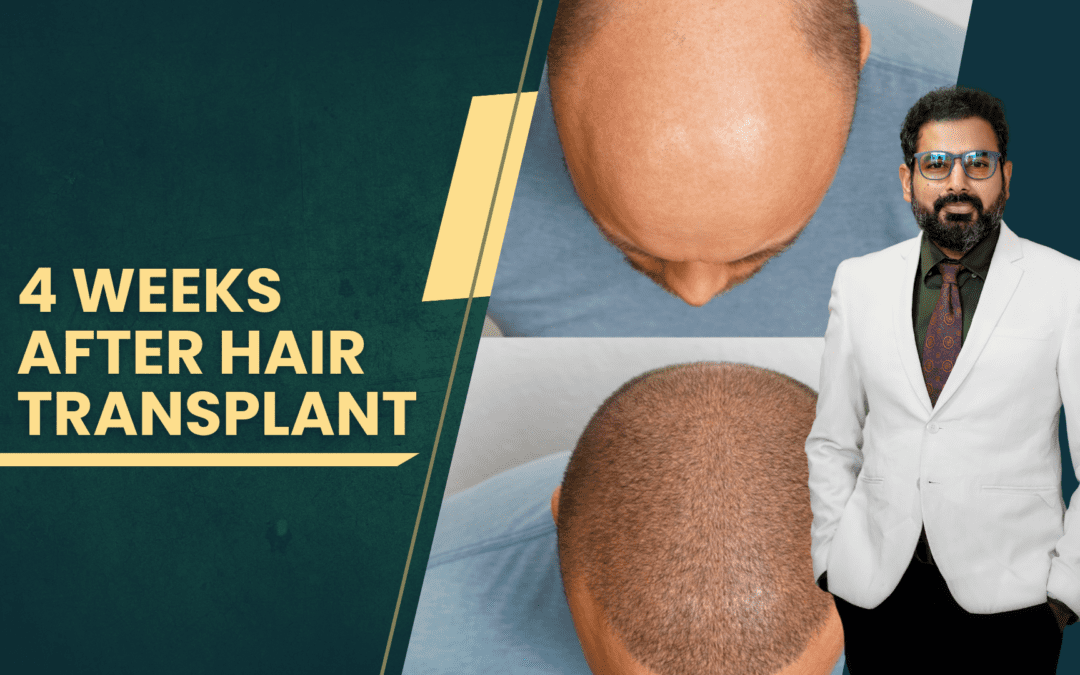Hair transplants are becoming increasingly popular for those seeking long-term solutions for hair loss. This transformative procedure entails extracting hair follicles from one area of the scalp and transplanting them to areas experiencing hair thinning or baldness. However, patients often wonder about the recovery process, particularly the critical period 4 weeks after hair transplant surgery.
With over two decades of experience, Dr. Chekuri has performed over 20,000 surgeries, including face and body contouring, breast surgeries, and hair transplant in Hyderabad at Redefine Plastic Surgery Centre. His expertise in hair restoration ensures patients receive the best care and guidance during their post-operative period.
At this point, many patients experience concerns such as hair shedding, scalp sensitivity, and whether they are healing properly. According to Dr. Harikiran Chekuri,
“These concerns are valid and addressing them is vital for ensuring a smooth recovery and optimal results. Understanding the changes in your scalp after surgery can help set realistic expectations.”
Is It Normal to Have Hair Loss 4 Weeks After Hair Transplant?
It is entirely normal to experience hair loss 4 weeks post hair transplant. This phenomenon, known as “shock loss,” occurs when transplanted hair follicles enter a resting phase. The body reacts to the trauma of surgery, causing some hair strands to fall out. This is usually a temporary situation.
This shedding can alarm patients, but it is actually a sign that the follicles are transitioning into the next phase of the hair growth cycle. Hair loss at this stage clears the way for new, stronger hair to grow in the following months. Within 3-4 months, most patients start to see new hair growth in the transplanted area.

Are you concerned about your hair transplant recovery? Consult with an expert today for the best advice. Book an appointment now!
Curious about what happens next? Let’s dive into the recovery timeline.
What to Expect 4 Weeks After Hair Transplant
At 4 weeks after FUE hair transplant, most patients can expect to see little to no hair growth. Instead, this period focuses on the shedding phase, followed by the body healing and preparing for new hair growth. The scalp may still feel tender, but overall discomfort should have subsided by now.
During the 4 weeks post op hair transplant period, patients can usually resume normal activities, although they should continue to avoid strenuous exercise, direct sun exposure, and harsh hair treatments.

While the visible progress may seem slow, rest assured that underneath the skin, the follicles are developing and preparing to produce stronger, healthier hair.
“Hair growth varies among individuals, and results can depend on various factors, including the method used for the transplant and the patient’s overall health,” explains Dr. Harikiran Chekuri, an acclaimed hair transplant surgeon in Hyderabad. Patience is essential during this time, as it takes several months to see the full results of the procedure.
Complications 4 Weeks Post Hair Transplant Surgery
While complications at this stage are rare, it’s essential to be aware of potential issues to look out for:
- Infection: Though rare, infections can develop at the transplant site. Symptoms may include increased redness, swelling, or discharge.
- Itching or Discomfort: Itching is common as the scalp heals. However, excessive scratching should be avoided to prevent damage to the hair follicles.
- Persistent Swelling: While some swelling is normal, excessive swelling should be evaluated by a professional.
- Folliculitis: This is a condition where hair follicles become inflamed, usually due to infection. It appears as small, red bumps around the transplant site.
- Scarring: Some patients may notice scarring at the donor or recipient sites, which can be minimized with proper aftercare.
- Poor Hair Growth: In some cases, patients may experience less than expected hair growth. This could be due to various factors, including individual healing responses or insufficient blood supply to the transplanted follicles.
Experiencing unusual symptoms post-surgery? Speak with a professional to address potential complications promptly. Book your consultation now!
Wondering how to care for your scalp in the coming weeks? Let’s dive into some essential tips.
Post-Operative Care: 4 Weeks After Hair Transplant
Proper care 4 weeks after hair transplant is crucial for optimal results. Some essential care tips include:
- Gentle Washing: Use a mild, sulfate-free shampoo to clean the scalp. Avoid vigorous scrubbing to prevent dislodging hair follicles.
- Avoid Harsh Products: Avoid styling gels, hair sprays, or chemicals.
- Avoiding Sun Exposure: Protect your scalp from direct sunlight. Wearing a loose hat can help shield the area during the healing phase.
- Avoiding Strenuous Activities: Avoid activities that cause excessive sweating or strain for at least four weeks.
- Stay Hydrated: Drinking plenty of water promotes overall health and can aid healing.
- Follow-Up Appointments: Regular check-ups with your specialist can help monitor your recovery and address any concerns.
By adhering to these guidelines, patients can maximize their chances of achieving the best results from their hair transplant.
When to Consult a Surgeon
- Persistent Pain: If you continue to feel discomfort or pain that doesn’t subside after a few weeks.
- Severe Swelling or Redness: Signs of infection or irritation that don’t improve may require attention.
- Hair Shedding Beyond Normal: If shedding continues beyond the expected timeframe, it’s best to consult a specialist.
- Signs of Infection: Increased redness, swelling, or discharge can indicate an infection requiring medical attention.
- Lack of Hair Growth: If you notice no improvement in hair growth after several months, it’s worth discussing with a professional

- Unexpected Symptoms: Any unusual sensations or changes should be reported to ensure proper care.
Conclusion
4 weeks after hair transplant is a pivotal time in the healing process. Shedding is normal, and with proper care, patients can look forward to new hair growth in the months ahead. Dr. Harikiran Chekuri and his team at Redefine Plastic Surgery Centre in Hyderabad are dedicated to ensuring every patient receives the guidance needed for a successful recovery.
Concerned about your post-transplant recovery or want to ensure the finest results? Consult an expert today for a personalized recovery plan. Book an appointment now!
Frequently Asked Questions:
Can I wear a hat 4 weeks after hair transplant?
You can wear a hat 4 weeks after hair transplant. However, choose a loose-fitting hat to avoid putting pressure on the scalp and ensure the transplanted follicles are not disturbed.
What if I notice pus at the transplant site?
If you notice pus or unusual discharge, consult your surgeon immediately, as it may indicate an infection.
Will my hair grow back thicker after the transplant?
While many patients experience increased hair density, results can vary based on individual healing responses.
Is scabbing normal after a hair transplant?
Light scabbing can occur as the scalp heals. Avoid picking at scabs to prevent dislodging hair follicles.
How long does the swelling last?
The swelling usually subsides within a week after surgery but may vary by individual; monitor for excessive swelling.
Disclaimer: This page is for informational purposes and not for promotional use.



